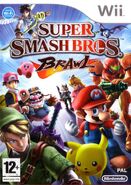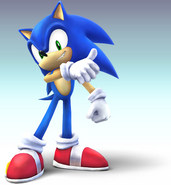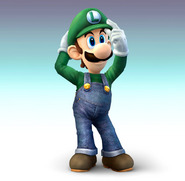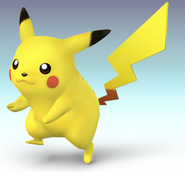No edit summary |
|||
| Line 190: | Line 190: | ||
*Bill Rogers - Lucario |
*Bill Rogers - Lucario |
||
*Lani Minella - Lucas, Pit |
*Lani Minella - Lucas, Pit |
||
| − | *[[Charles Martinet]] - Mario, Luigi, Wario |
+ | *[[Charles Martinet]] - Mario, Luigi, Wario, Waluigi |
*Hikaru Midorikawa - Marth |
*Hikaru Midorikawa - Marth |
||
*Jay Ward - Wolf |
*Jay Ward - Wolf |
||
Revision as of 22:33, 21 June 2013
Super Smash Bros. Brawl, known in Japan as Dairantou Smash Brothers X (大乱闘スマッシュブラザーズX, Dairantō Sumasshu Burazāzu Ekkusu, lit. "Great Melee Smash Brothers X"), often shortened to SSBB or Brawl, is the third installment in the Super Smash Bros. series published by Nintendo. Like the other games in the series, it features a diverse roster of characters from Nintendo and its second parties to fight in various kinds of matches. However, Brawl is the first Super Smash Bros. game to feature third-party characters. Most of the game's music is made up of arranged versions of pieces that originated in previously released Nintendo video games; though some play exactly as they did in their original games, others are arranged by one of 36 renowned video game composers.
As with its predecessors, Super Smash Bros. Brawl is a departure from traditional fighting games, notably in its simplified move commands and its emphasis on ring-outs over knockouts. Brawl includes a deeper single player mode than its predecessors, known as The Subspace Emissary, this mode is a side-scroller featuring the playable characters and a unique storyline. The storyline of this mode involves characters surviving under the weight of their own histories. Brawl supports multiplayer battles with up to four combatants - and is the first game in its franchise to support online battles through Nintendo Wi-Fi Connection.
Characters
Main article: Character
The cast of characters includes various returning characters from Melee as well as a variety of newcomers to the game. Some returning characters have been updated or refined since their last appearance - in terms of appearance, fighting capabilities, or both. For example, Link and Fox McCloud have taken on new designs from more recent titles, while Samus Aran has gained the ability to change into a new form, Zero Suit Samus, by using her Final Smash.
Some previously represented series have had one or more of their other characters added to Brawl. Diddy Kong (from the Donkey Kong series) and Ike (from the Fire Emblem series) make their first appearance in the Smash Bros. series, preceded by Donkey Kong and Marth, respectively.
Other newcomers are the first to represent their series: characters like Pit, representing the Kid Icarus series, which has not been seen in a videogame since the 1991 Game Boy game Kid Icarus: Of Myths and Monsters; Wario, an occasional antagonist of Mario's from Nintendo's highly successful WarioWare and Wario Land series; Captain Olimar from the Pikmin series; Solid Snake, the main protagonist of the Metal Gear franchise, who is the first third-party character to appear in a Super Smash Bros. game and Sonic from Sonic the Hedgehog, the second third-party character.
Playable Characters
* means that a character has returned, and ~ means new character.
- Bowser*
- Donkey Kong*
- Diddy Kong~
- Fox*
- Ice Climbers*
- Ike~
- King Dedede~
- Kirby*
- Link*
- Lucas~
- Mario*
- Meta Knight~
- Olimar~
- Peach*
- Pikachu*
- Pit~
- Pokémon Trainer~
- Samus*/Zero Suit Samus~
- Wario~
- Yoshi*
- Zelda*/Sheik*
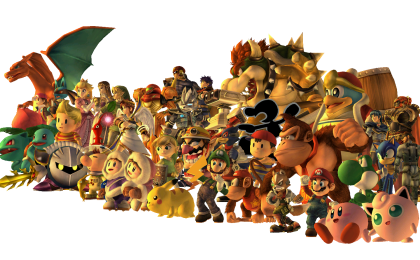
Complete cast of characters excluding ZSS and Sheik.
Unlockables
- Captain Falcon*
- Falco*
- Ganondorf*
- Jigglypuff*
- Lucario~
- Luigi*
- Marth*
- Mr. Game & Watch*
- Ness*
- R.O.B.~
- Snake~
- Sonic~
- Toon Link~
- Wolf~
Bosses
- Fighting Alloy Team
- Master Hand*
- Crazy Hand*
- Petey Piranha
- Rayquaza
- Galleom
- Duon
- Ridley
- Meta Ridley
- Porky Minch
- Porky Statue
- Tabuu
Stages
There are 41 stages in the game
* means that a level has return from Melee
- Battlefield
- Final Destination
- Delfino Plaza
- Mushroomy Kingdom
- Norfair
- Frigate Orpheon
- Bridge of Eldin
- Rumble Falls
- Mario Circuit
- Yoshi's Island
- Halberd
- Lylat Cruise
- Pokemon Stadium 2
- Smashville
- Distant Planet
- WarioWare, Inc.
- Castle Siege
- Port Town Aero Dive
- New Pork City
- Summit
- Skyworld
- Shadow Moses Island
- PictoChat
- Temple*
- Yoshi's Island*
- Rainbow Cruise*
- Corneria*
- Onett*
- Brinstar*
Unlockables
- Mario Bros.
- Green Hill Zone
- Luigi's Mansion
- Spear Pillar
- 75m
- Flat Zone 2
- Jungle Japes*
- Green Greens*
- Pokemon Stadium*
- Big Blue*
- Hanenbow
- Pirate Ship
Collectibles
Returning from Melee are trophies, statuettes of Nintendo characters and objects that can be collected in the game. These trophies give a brief history of the object it shows. In addition to trophies, players will now be able to collect stickers of Nintendo artwork. Players will be able to place stickers and trophies onto virtual backgrounds and record snapshots, which can be sent to other players via Nintendo Wi-Fi Connection. Another new item appearing in the game is CDs, which, when obtained, offers new music choices for playable stages. By completing stages in the Classic Mode, coins can be earned. The coins can be used to play the Coin Launcher to get stickers or trophies.
Development
At the pre-E3 2005 press conference, the president of Nintendo, Satoru Iwata, announced the next installment of Super Smash Bros. was not only already in development for their next gaming console, but would be a launch title with Wi-Fi compatibility for online play. The announcement was unexpected to the creator of the Super Smash Bros. series, Masahiro Sakurai. Back in 2003, he had left HAL Laboratory, the company that was in charge with the franchises' and the Kirby series' development and was never informed of this announcement despite the fact shortly after resigning from the company, Iwata said if a new game was to be made, he would be in charge. It was not until after the conference Sakurai was called to Satoru Iwata's room on the top floor of a Los Angeles hotel where he was told by Iwata, "We'd like you to be involved in the production of the new Smash Bros., if possible near the level of director". Although originally announced to be a launch title, Sakurai stated "I decided to become director. And as of May, 2005, I was the only member of the new Smash Bros. development team". Development of the game never actually started until late 2005, and just for its production, Nintendo opened a new office in Tokyo at the beginning of October 2005. Nintendo also enlisted outside help from a company who, at that point in time, just finished development of a major title. Sakurai also stated that these people had spent excessive amounts of time playing Melee. This team will have access to all the original material and tools from the development of Melee, courtesy of HAL Laboratory. Also, several Smash Bros. staff members that reside around the area of the new office have joined up on the project's development.

Sonic fighting with Mario on the Lylat Cruise stage.
At the Nintendo Media Conference at E3 2007, it was announced by Nintendo of America president Reggie Fils-Aime that Brawl would be released on December 3, 2007 in the Americas. However, just two months before its anticipated December release, the development team asked for more time to work on the game. During the Nintendo Conference on October 10, 2007, Nintendo of Japan president Iwata announced the delay, saying:
| “ | In order to fine tune Smash Bros., with this unprecedented game depth, we have decided that we have to take a little more time to complete the game than we announced before. We are sorry for the fans that are already anxiously waiting for the launch, but we would like to launch this game on January 24th, 2008 in Japan. As for the North American launch, we will review that too, and our local subsidiaries will make their own announcements. | ” |
On October 11, 2007, George Harrison of Nintendo of America announced that Brawl would be released on February 10, 2008 in North America, but was later changed to March 9, 2008.
Music
- See also: My Music, Music (SSBB), Super Smash Bros. Brawl Main Theme
On May 22, 2007, Sakurai revealed a list of thirty-six composers providing music for the game. Sakurai stated that he had asked the composers, who come from a variety of companies and have written music for first-, second-, and third-party games, "to listen to an elite selection of Nintendo music and arrange several of their favorite songs." The game's various stages have multiple musical tracks which players can listen to using the new "My Music" feature, including some songs that were taken directly from other games without any modification or special arrangement. This feature also allows the player to adjust the frequency of how often a song gets played during a stage. It is possible to unlock more songs on this feature by collecting CDs during gameplay.
Masterpieces
- Main article: Masterpieces
Masterpieces are a new feature to the Super Smash Bros. series. They are Virtual Console demo versions of several older Nintendo games, each one featuring at least one of the characters playable in Brawl. Some of them must be unlocked, and all of them have time maximums. Interestingly, the Japanese release has two more masterpieces than the international releases. These two masterpieces are EarthBound and Fire Emblem: Monsho no Nazo.
Trailers
Several different trailers for Brawl were released before the game came out. The original trailer was shown at E3 2006 on May 11, 2006 and revealed Solid Snake as a playable character. A second trailer was shown at the Nintendo World 2006 convention in December, and revealed Fox's return as a playable character. A third trailer was shown as the October 10, 2007 Nintendo Press Conference, which revealed Sonic as a playable character. A final trailer showcasing Brawl's adventure mode, the Subspace Emissary, was released on Friday, December 21, 2007. This trailer revealed that Ike and the Ice Climbers would appear in this mode, among other things.
Reception
Brawl was received with positive reviews, with ratings equal or slightly better than Melee. The game's multiplayer was received excellently, but single player, while noted as superior to Melee's, was still only average.
Changes from Melee to Brawl
The most prominent Brawl-Melee change is the new physics. Generally, the game plays slower - every veteran has a slower fall speed, L-cancelling has been removed, and characters must wait a slight amount of time before being able to Meteor Cancel. Most notably, the air dodge does not involve characters shifting in a direction - instead, characters continue on whatever path they were moving before the air dodge. This new air dodge does not put characters into a helpless state, and also makes wavedashing impossible. Because of this, some consider Super Smash Bros. Melee to be superior to Super Smash Bros. Brawl. New to Brawl, there is also a buffer system, which makes pulling off certain moves or strings of moves easier. This allows for the player to input a move within 10 frames of the previous move ending.
There have been multiple improvements and additions. There are no true spikes in Brawl; all attacks that have a downwards angle are Meteor Smashes but they cannot be meteor-canceled as early as they could be in Melee. All characters can now do something similar to a Meteor Smash with the addition of the Footstool Jump. Characters can grab an edge if they're facing the wrong way which lowers the usefulness of some attacks such as Mario's cape. Characters can pummel faster and some can crawl, while others can glide or wall cling, and all of them can swim.
However, there are some changes that were not liked. Hitstun in Brawl is significantly decreased and can be air dodged or attacked out of; this makes true combos almost nonexistent. Despite this, certain attacks have extreme hitlag. Not all characters can Meteor Cancel by jumping, and the window for dash-dancing is so small it loses almost all its usefulness. Tether Recoveries are generally less useful than the wall-grappling they replaced. Characters must wait an amount of time before being able to move after grabbing an edge. Shieldstun is also drastically decreased, has increased Perfect Shield window, and it only takes 7 frames to shield drop, making the game even more focused on defensive game. There is also a landing lag glitch on several characters (not all) that makes them get the landing lag the next time it lands from the air if using a move that makes helpless and grabs the ledge after using a such move.
Aside from the inclusion of new characters, stages and items, there are various other changes, including the addition of the Final Smash. Grab release mechanics have changed, allowing for more grab release chain grabs. Wave Dashing has been removed. CPUs generally gained an AI increase but do not DI very much - perhaps because it has been limited, although easier to do. Grabbing a character does not restore their double jump(s), and short hopping is made easier as characters are a bit slower at jumping. Smash Taunts do not end if the user flinches; he has to be KO'd to end it early. Up smashes can be performed while running. Some characters' smashes and tilts can be angled up or down. Characters can now pivot grab. If a move is extremely close to hitting another character, it will be a glancing blow and a few sparks will show up. All characters now have three taunts instead of one.
Outside of the main game, players can build custom stages and save snapshots and replays. Melee's Adventure Mode has evolved into The Subspace Emissary, while Event Matches have selectable difficulties and the Home-Run Contest puts a temporary shield around the platform - all of these modes can also be played in Co-op. Players can also play online in various modes.
Voice actors
- Eric Newsome - Bowser, Meta Knight
- Ryō Horikawa - Captain Falcon
- Shin'ichirō Miki - Charizard
- Katsumi Suzuki - Diddy Kong
- Takashi Nagasako - Donkey Kong
- Dex Manley - Falco
- Jim Walker - Fox
- Hironori Miyata - Ganondorf
- Sanae Kobayashi - Ice Climbers
- Jason Adkins - Ike
- Craig Blair - Ivysaur
- Rachael Lillis - Jigglypuff
- Masahiro Sakurai - King Dedede
- Makiko Ōmoto - Kirby, Ness
- Akira Susanuma - Link
- Bill Rogers - Lucario
- Lani Minella - Lucas, Pit
- Charles Martinet - Mario, Luigi, Wario, Waluigi
- Hikaru Midorikawa - Marth
- Jay Ward - Wolf
- Samantha Kelly - Peach
- Ikue Ōtani - Pikachu
- Michele Knotz - Pokémon Trainer, Squirtle
- David Hayter - Solid Snake
- Jason Griffith - Sonic
- Sachi Matsumoto - Toon Link
- Kazumi Totaka - Yoshi
- Jun Mizusawa - Zelda, Sheik
- Alésia Glidewell - Zero Suit Samus
- Pat Cashman - Narrator, Master Hand, Crazy Hand
Codec:
- Paul Eiding - Roy Campbell
- Christopher Randolph - Otacon
- Kim Mai Guest - Mei Ling
- Jim Walker - Leon Powalski
- Dex Manley - Peppy Hare, Panther Caruso
- Alésia Glidewell - Krystal
- Michael McAuliffe - Slippy Toad
Note: Mr. Game & Watch, Olimar, R.O.B and Samus have no voices, therefore, no voice actors. It was rumored that voice actor Jim Cummings voiced Bowser in this game, but this rumor was later proved false.
Gallery
Trivia
- To the dismay of many NTSC owners of Brawl, the game does not come with Japanese audio or text options as Super Smash Bros. Melee did.
- The announcer does not yell the game's title at the title screen, unlike the other games in the series.
- The opening does not show hidden characters (such as Toon Link, Wolf, etc.) until unlocked, like in the first Super Smash Bros., with the exception of Ness, Marth, Sonic and Snake.
- Some non-human characters (like Donkey Kong and Diddy Kong) use more realistic sounds rather than their usual cartoonish sounds in their own games.
- The Brawl menu was designed almost identically to Kirby Air Ride, along with the Challenges Checklist.
- While the Wii Remote speaker is generally unused, there are two instances where it is used:
- When a player selects a character, the character will make a noise through the speaker, but only some remotes will do this.
- After minigames on Wario Ware, Inc., a different sound effect will be heard depending on how the player did.
- Kid Icarus Uprising seems to have picked up some things from Brawl, such as a Boss Battle mode, a dash mechanic, a checklist for challenges, etc.
- Super Smash Bros. Brawl is even referenced out loud by Palutena and Pit, Palutena referring to it as Super Bash Sisters out of forgetfulness.



